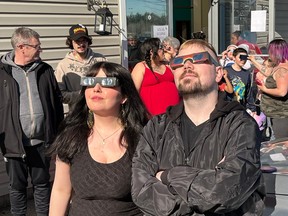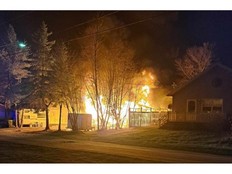Elder says eclipse gave feelings of 'hope and unconditional love'
More than 100 people viewed total eclipse at Pabineau First Nation event

Article content
Connie Sewell sat touching the Earth, saying prayers, with a smudge situated nearby as the solar eclipse came into totality over Pabineau First Nation.
“It felt beautiful … Just being in that moment, and appreciating that moment, and who I am and appreciating everyone and also my prayers of what I’d like to see of the future,” the community elder knowledge keeper said as the sun’s strength continued to increase overhead following the total eclipse April 8.
Pabineau was the only place in the Chaleur region promoting a public viewing party of the eclipse with more than 100 people from the community and region watching together outside the community hall.
The wind picked up and the temperature began to drop as the moon inched closer to its complete cover of the sun. People oohed and ahhed as the last sliver of sun disappeared, in one of the only places in the Chaleur region to reach totality.
“Just everyone being together to experience it and the excitement and the children and the laughter and the happiness of everyone with everyone around. You feel that energy. It feels good,” Sewell said.

Felicia Mae Galbraith, director of education for Pabineau, witnessed a total solar eclipse with her husband Jeremy while living in Charleston, South Carolina, in 2017. Realizing the community was in the path of a total eclipse, Galbraith wanted to share the educational experience with the students and the community.
“I really wanted to see that again because it’s so spectacular,” she said. “I really wanted to share that with everybody.”
Galbraith said the event was a learning opportunity, with everyone “buzzing” with chatter in the days leading up to the main event.
In Mi’gmaq teachings, Galbraith said an eclipse represents the grandmother moon and the grandfather sun coming together at a “time of peace and calm.”
“When they’re coming together, that’s special,” she said.
People leave out water to be charged by the energy of the solar eclipse, praying and speaking their intentions for the future. They pour out the water to return it to Mother Earth after the eclipse ends.
“The energy of the solar eclipse will charge the water and apparently it’s very medicinal and healing,” Galbraith said.
Indigenous communities celebrate the eclipse in different ways. Galbraith said an eclipse is a type of ceremony in itself.
“Spiritually, I think an Indigenous person’s connection to their culture and spirituality is personal and sometimes private,” she said. “I think it’s a time that’s meant for yourself.”
Sewell said the coming together of the sun and moon represents the restoring of balance, healing and renewal.
“It gives you that beautiful vision of hope and unconditional love and it gives you all those nice things to help move you forward.”
Chief Terry Richardson said events like the eclipse viewing are an important tool to help pass cultural knowledge to the next generation.
“Those teachings are important for the next seven generations so they’re all following those teachings. That’s why it’s important,” he said.











Postmedia is committed to maintaining a lively but civil forum for discussion. Please keep comments relevant and respectful. Comments may take up to an hour to appear on the site. You will receive an email if there is a reply to your comment, an update to a thread you follow or if a user you follow comments. Visit our Community Guidelines for more information.